
95% of researchers rate our articles as excellent or good
Learn more about the work of our research integrity team to safeguard the quality of each article we publish.
Find out more
ORIGINAL RESEARCH article
Front. Ecol. Evol. , 20 October 2022
Sec. Paleoecology
Volume 10 - 2022 | https://doi.org/10.3389/fevo.2022.992980
This article is part of the Research Topic Effects of Novel Environments on Domesticated Species View all 19 articles
In archeological studies, the Qin people have often been a subject of research. The areas of investigation about the Qin include their origin, structure of tombs, funeral rites and interment processes, and cities and settlements. Although there are some studies on the Qin people’s diet which were conducted through isotope analyses, research on the agricultural system of the Qin people is still limited, especially during the period from the Qin people’s settlement in the Guanzhong Basin to the First Emperor bringing the seven states under his dominion. In the backdrop of the Warring States Period, it is necessary to investigate the nature of the Qin people’s agricultural economy and how it impacted their social progress. This study evaluates the Qin people’s agricultural practices based on flotation results from the Matengkong site, located southeast of the Guanzhong Basin in Shaanxi province. The results showed that the inhabitants practiced multi-cropping, and the crop assemblage comprised five categories, including dominant foxtail millet (Setaria italica) and wheat (Triticum aestivum), important broomcorn millet (Panicum miliaceum), less important soybean (Glycine max) and adzuki bean (Vigna angularis), less utilized barley (Hordeum vulgare), and cannabis (Cannabis sativa), and rice (Oryza sativa) of the lowest utilization. Wheat planting played a consistent and important role in agricultural production, and it appears to have had a high yield as same as foxtail millet. However, it appears to have contributed a small part of dietary intake. Rice does not appear to have been an important part of the Qin people’s subsistence at the site and there is no supporting evidence that rice was grown at Matengkong. Rather, it is possible that rice might have been imported from Chu, a neighboring state to the south of Qin, through the ancient mountain passage. Adzuki bean, as a kind of crop resource, was widely used during the Zhou Dynasty. Moreover, Chenopodium sp. and Vitex negundo appear to have been intentionally used because of the high density in each single sample, but they might be multifunctional in nature.
The Qin Empire played an important role in the development of Chinese civilization. Historically, the consensus has been that the Qin people replaced the Zhou to take Guanzhong Basin as their capital and environs. The Qin people gained complete victory during the end of the Warring States Period (475–221 BC), leading to the establishment of the Qin Dynasty (221–207 BC), which was the first unified multi-ethnic feudal empire of China (Sima, 1959; Wang, 2006; Liang, 2020).
The Guanzhong Basin is situated between the Qinling Mountains and Loess Plateau, ranging from Baoji in the west to Weinan in the east. It is an alluvial plain formed by the branches of the Yellow River, such as the Wei River, Jing River, and Luo River (Zhang, 2016). The landform is open and flat with fertile soil (Huang, 1988). The climate in this region is typically temperate monsoon with four distinct seasons and moderate temperatures, which has afforded the Qin rich agricultural production (Nie, 1981). However, there is a dearth of literature examining the Qin people’s economics, and it is better to rely on archeological discoveries and research that often are associated with various sciences and technologies, such as archaeobotany.
Archaeobotanical research on the Guanzhong Basin has mainly focused on the Neolithic Period Sites, e.g., Zhouyuan (Zhao and Xu, 2004), Yuhuazhai (Zhao, 2017), Dongyang (Zhao, 2019), Yangguanzhai (Tang et al., 2020a), Xinglefang (Liu H. et al., 2013), Xiahe (Shang et al., 2012), Anban (Liu, 2014), and Xinjie (Zhong et al., 2015). There are a few archaeobotanical studies on the sites of the Bronze Age, such as Dongyang (Zhao, 2019), Gongbeiya (Tang et al., 2020b), and Zhouyuan (Zhao and Xu, 2004). However, these are all studies about the Zhou people’s diet and agricultural practices. By analyzing the flotation results from the Matengkong site, a Qin cultural site, it is possible to study the Qin people’s plant utilization, especially crop resources, after the Zhou people’s emigration to the Central Plains.
The Matengkong Site (109°2′12.4″E, 34°12′42.6″N) is located in the Matengkong Village, Xi’an City, in the Shaanxi Province in the southeastern region of the Guanzhong Basin. The site is on the second terrace on the west bank of the Chan River (Figure 1), with an area of about 3 ha; in the past, it was a small low-status settlement that represented an average farming settlement, and hence, the everyday subsistence of Qin people during this period. From 2016 to 2018, the Shaanxi Academy of Archeology excavated the site scientifically and systematically (Figure 2). Chronologically speaking, there are five cultural strata of the site, including the Yangshao Period, and the Eastern Zhou, and Sui, Ming, and Qing dynasties, among which cultural relics from the Eastern Zhou Dynasty (770-256 BC) are abundant, including the Spring and Autumn Period (770-476 BC) and the Warring States Period (475-221 BC) (Wang and Xu, 2019). More than 270 tombs of the Qin people from the Eastern Zhou Dynasty have been unearthed, which were located in the north of the dwelling zone (Wang and Xu, 2019).
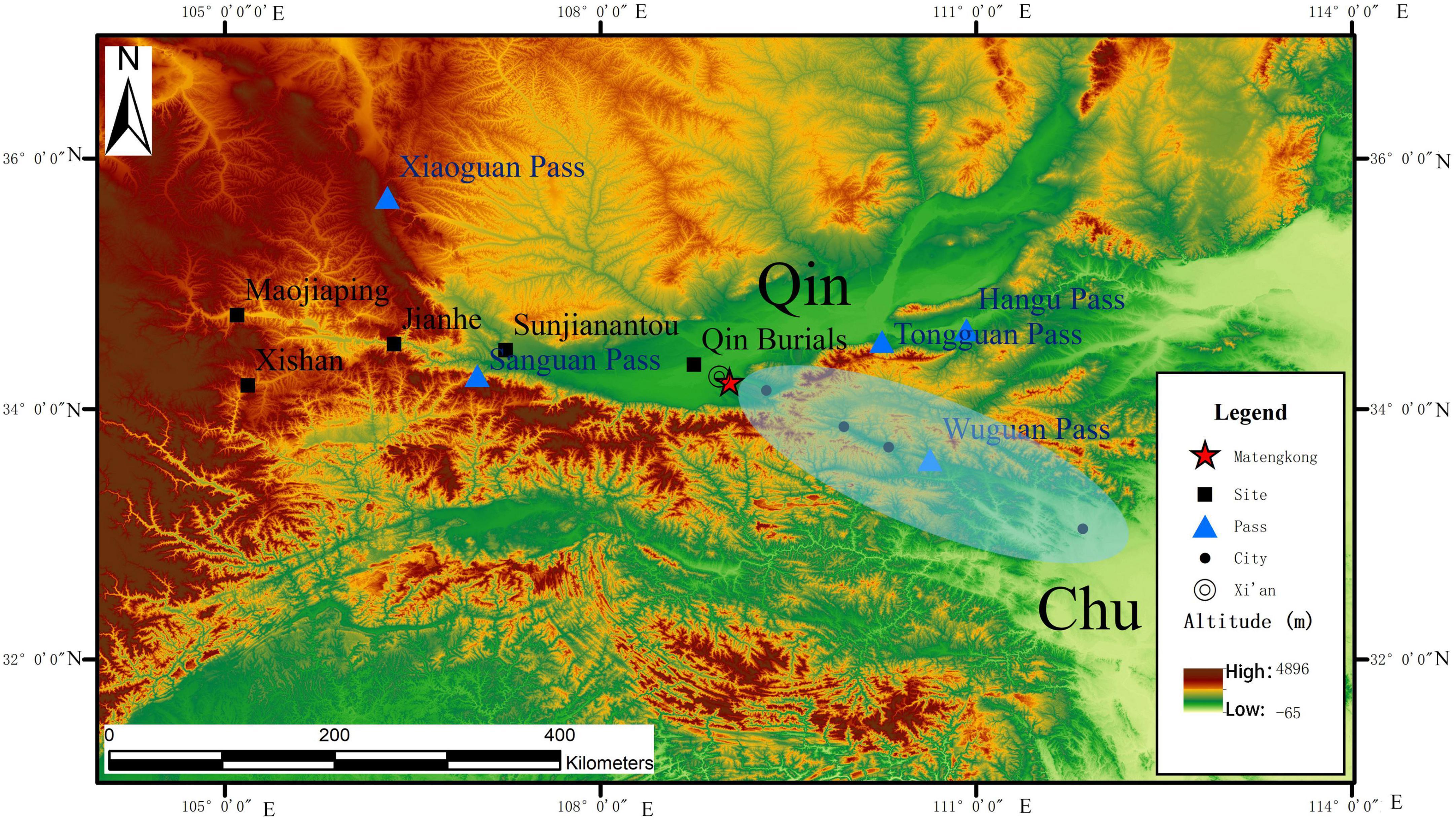
Figure 1. Location of Matengkong and Shang-Wu Road (The light blue shadow covers the Shang-Wu Road).
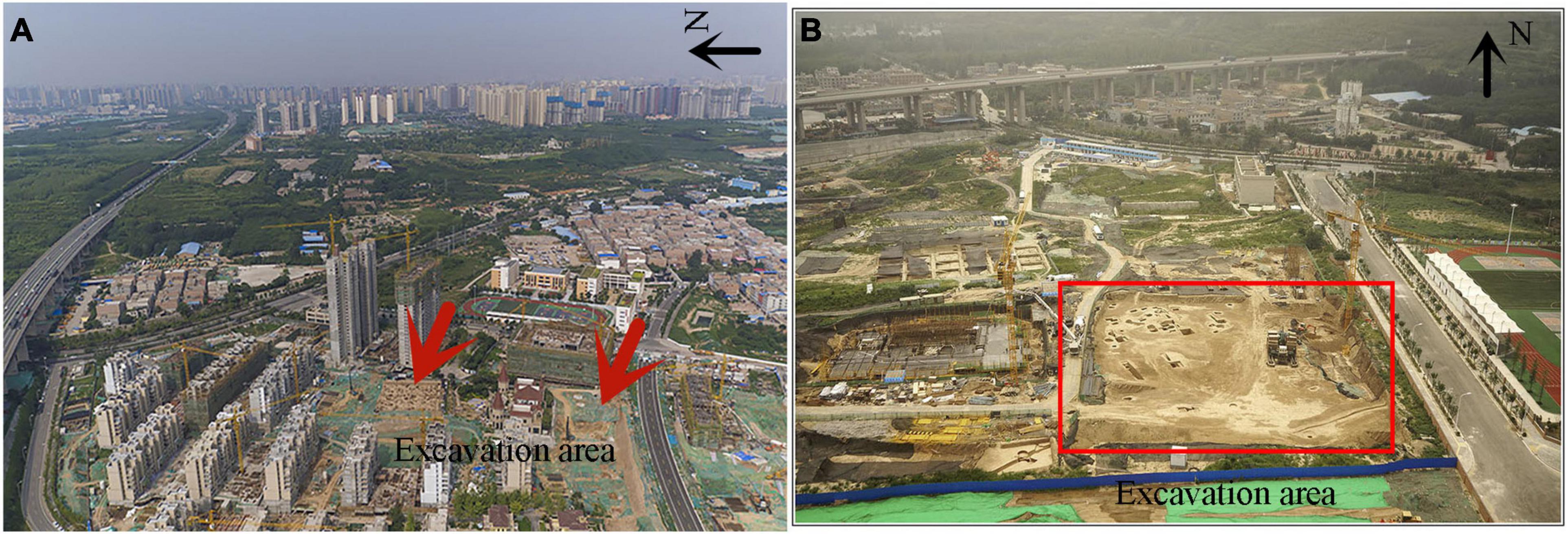
Figure 2. (A) Overview of the Matengkong site (red arrow showing the exact location). (B) On site excavation in 2016–2018 (prepared by Zhiyou Wang).
For accurate information regarding the distribution of plant remains as well as the Qin people’s utilization of plants, soil samples from 2016 to 2018 were collected from the ruins, such as ash pits, dwelling floors, and kilns (Zhao, 2004, 2010). In total, 108 soil samples were collected, which have been presented in Table 1 along with their chronological backgrounds. Because of the small sample size of the Yangshao, Spring and Autumn, and Sui and Tang periods, this study is only an analysis of the plant utilization of the Qin people from the Warring States Period to the Qin Dynasty, from which 838.6 L of soil were collected in 87 samples. The Qin Dynasty was short-lived, lasting for only 15 years (Sima, 1959), and in terms of Qin cultural relics, there is no precise method to distinguish the Warring States Period from the Qin Dynasty. Therefore, the 87 samples under examination were categorized together roughly as between the Warring States Period and Qin Dynasty.
The plant remains were floated at the site by the wash-over bucket flotation method (Pearsall, 2000; Zhao, 2004; Fuller, 2008). Plant macro-remains were collected in sieves of the mesh size of 0.2 mm, air dried, and then further studied in the Archaeobotanical laboratory, School of Cultural Heritage, Northwestern University, for identification and analysis. The characteristics of the morphology of the plant seeds were observed and photographed under a Nikon SMZ25 stereomicroscope. The revised English version of Flora of China was followed for plant nomenclature.
An array of quantitative statistics are conducted, such as absolute number, percentage, ubiquity, and density of seeds. As for the procedures employed in the laboratory, we followed the guidelines enumerated in the Paleoethnobotany: A Handbook of Procedures (Pearsall, 2000, 2015), Specification for the flotation work and laboratory analysis of archeological plant remains (National Cultural Heritage Administration, 2012), and Laboratory Procedures of Paleoethnobotany (Zhao, 2010).
In total, 48,432 carbonized plant remains were found in 87 soil samples (see the Supplementary material of identification results in detail), including crop remains and non-crop remains, all of which can be grouped into 38 categories, representing 19 plant families (Supplementary Table 1). Among them, there were 17,708 seeds of eight kinds of crops (Figure 3), including foxtail millet (Setaria italica), broomcorn millet (Panicum miliaceum), wheat (Triticum aestivum), barley (Hordeum vulgare), rice (Oryza sativa), soybean (Glycine max), adzuki bean (Vigna angularis), and cannabis (Cannabis sativa). Foxtail millet and wheat were found to be two of the most critical crops among the crop remains, with foxtail millet being more ubiquitous than wheat. The ubiquity for foxtail millet was 100% with 15,490 grains, and that of wheat was 85.06% with 1,612 grains. The other crops were in the minority exhibiting low quantities and ubiquity. For example, broomcorn millet showed 34.48% ubiquity with 406 grains; the two kinds of legume, soybean, and adzuki bean, showed around 20% ubiquity with less than 100 grains; barley showed 13.79% ubiquity with 32 grains; cannabis showed 6.90% ubiquity with 11 grains; and finally, rice showed 3.45% ubiquity with only 10 grains.
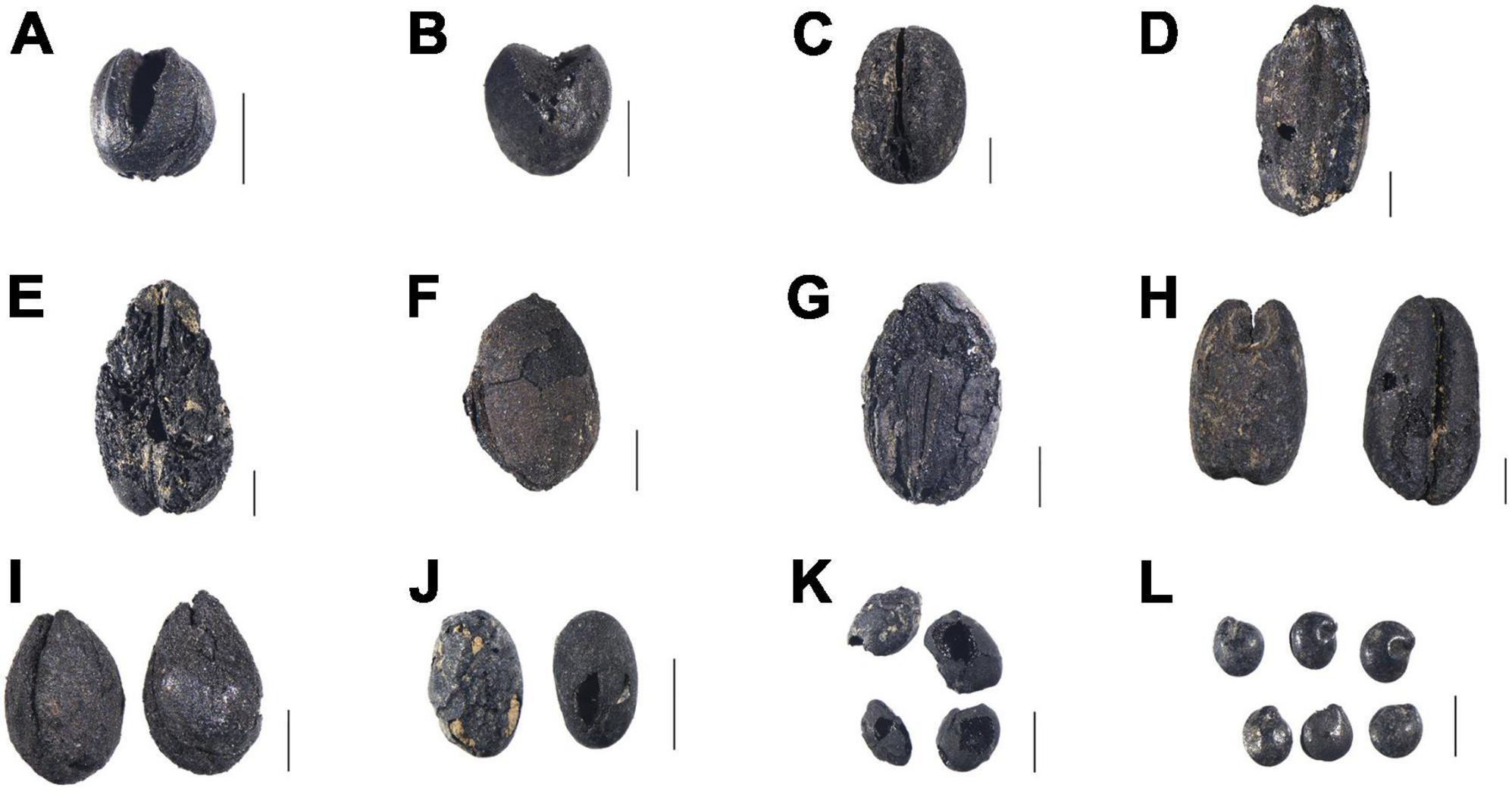
Figure 3. Main crop macro-remains and some larger quantities of non-crops macro-remains. (A) Setaria italica, (B) Panicum miliaceum, (C) Vigna angularis, (D) Oryza sativa, (E) Hordeum vulgare, (F) Cannabis sativa, (G) Glycine max, (H) Triticum aestivum, (I) Vitex negundo, (J) Lespedeza sp., (K) Melilotus sp., (L) Chenopodium sp. scale bars = 1 mm.
A total of 30,724 non-crop seeds and seed fragments were identified from Matengkong (Figure 4), such as Setaria sp., Fabaceae, Avena fatua, Phalaris arundinacea, Glycine soja, Vicia sepium, Lespedeza sp., Melilotus sp., Vitex sp., Vitex negundo, Vitex negundo var. heterophylla, Chenopodium sp., Salsola collina, Suaeda glauca, Kochia scoparia, Malva sp., Apiaceae, Viola sp., Allium tuberosum, Acalypha australis, Galium tricornutum, Fimbristylis sp., Schoenoplectus triqueter, Polygonaceae, Polygonum lapathifolium, Patrinia sp., Thladiantha dubia, Calystegia hederacea, Plantago asiatica, Vitis sp., and Ziziphus jujuba. The taxonomic level of identification varied depending upon the quality of the specimen, the amount of morphological distinguishability among species in a genus, and the availability of comparative specimens for all species of that particular genus/family.
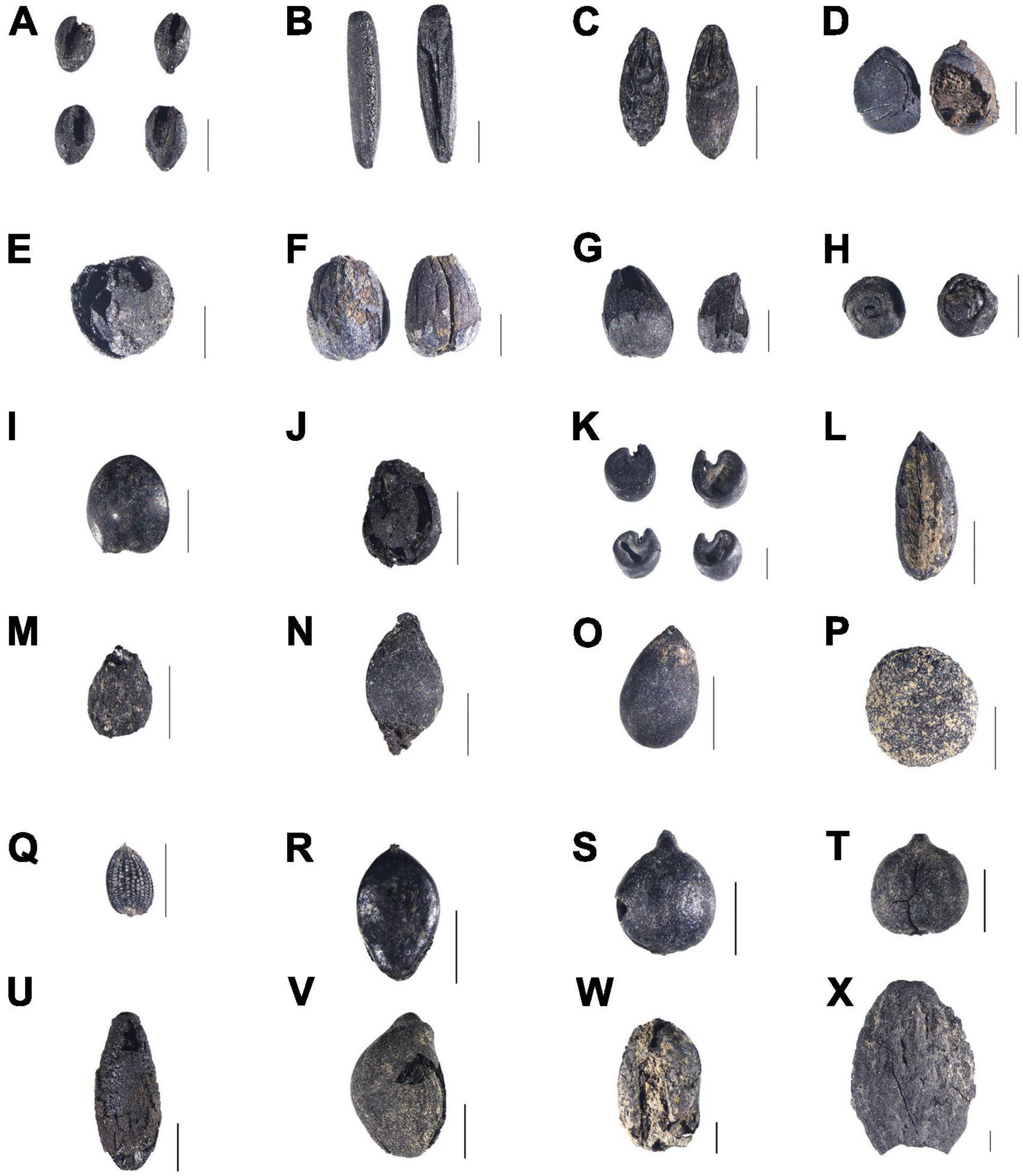
Figure 4. Other non-crops macro-remains in smaller quantities. (A) Setaria sp., (B) Avena fatua, (C) Phalaris arundinacea, (D) Glycine soja, (E) Vicia sepium, (F) Vitex sp., (G) Vitex negundo var. heterophylla, (H) Salsola collina, (I) Suaeda glauca, (J) Kochia scoparia, (K) Malva sp., (L) Apiaceae, (M) Viola sp., (N) Allium tuberosum, (O) Acalypha australis, (P) Galium tricornutum, (Q) Fimbristylis sp., (R) Schoenoplectus triqueter, (S) Polygonaceae, (T) Polygonum lapathifolium, (U) Thladiantha dubia, (V) Calystegia hederacea, (W) Vitis sp., (X) Ziziphus jujuba, scale bars = 1 mm.
Among the plant remains from the Matengkong site, the quantity and density of Chenopodium sp. were both unusually high. The quantity of this kind of nutlet in one sample from the ash pit H1835 was up to 26,240 contained in 19 L of soil. To avoid underestimating the roles that 79.79% of components played in the plant assemblage, the data of Chenopodium seeds are excluded from statistical analysis. Of course, it can certainly be inferred that Chenopodium sp. played an important role in ancient times, which is discussed in Section “Discussion” below.
The crop assemblage at Matengkong from the Warring States Period to the Qin Dynasty was arranged in order of rank derived from the quantitative analysis. It shows the decreasing importance from foxtail millet and wheat to broomcorn millet, soybean and adzuki bean, barley, cannabis, and rice (Table 2 and Figure 5).
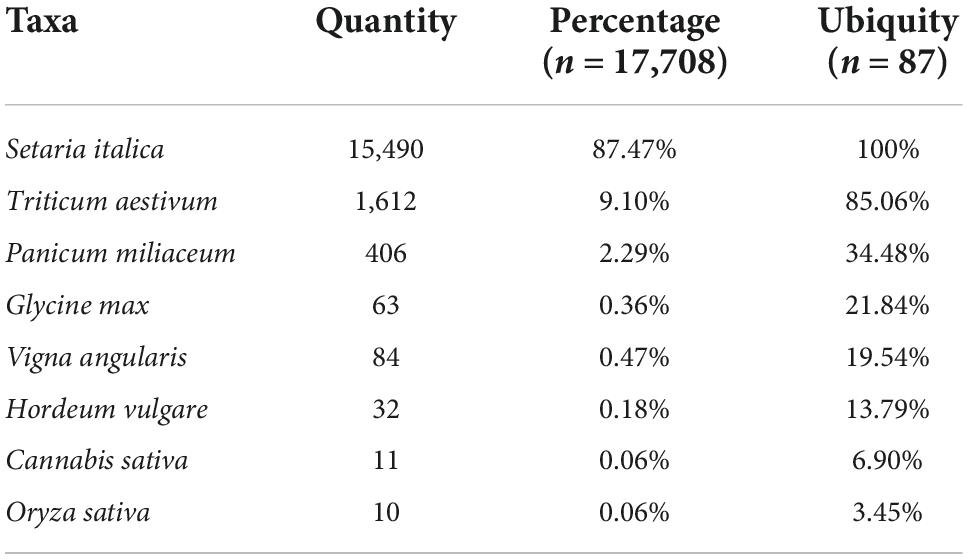
Table 2. Crop seed quantity, percentage, and ubiquity at Matengkong from the Warring States Period to the Qin dynasty.
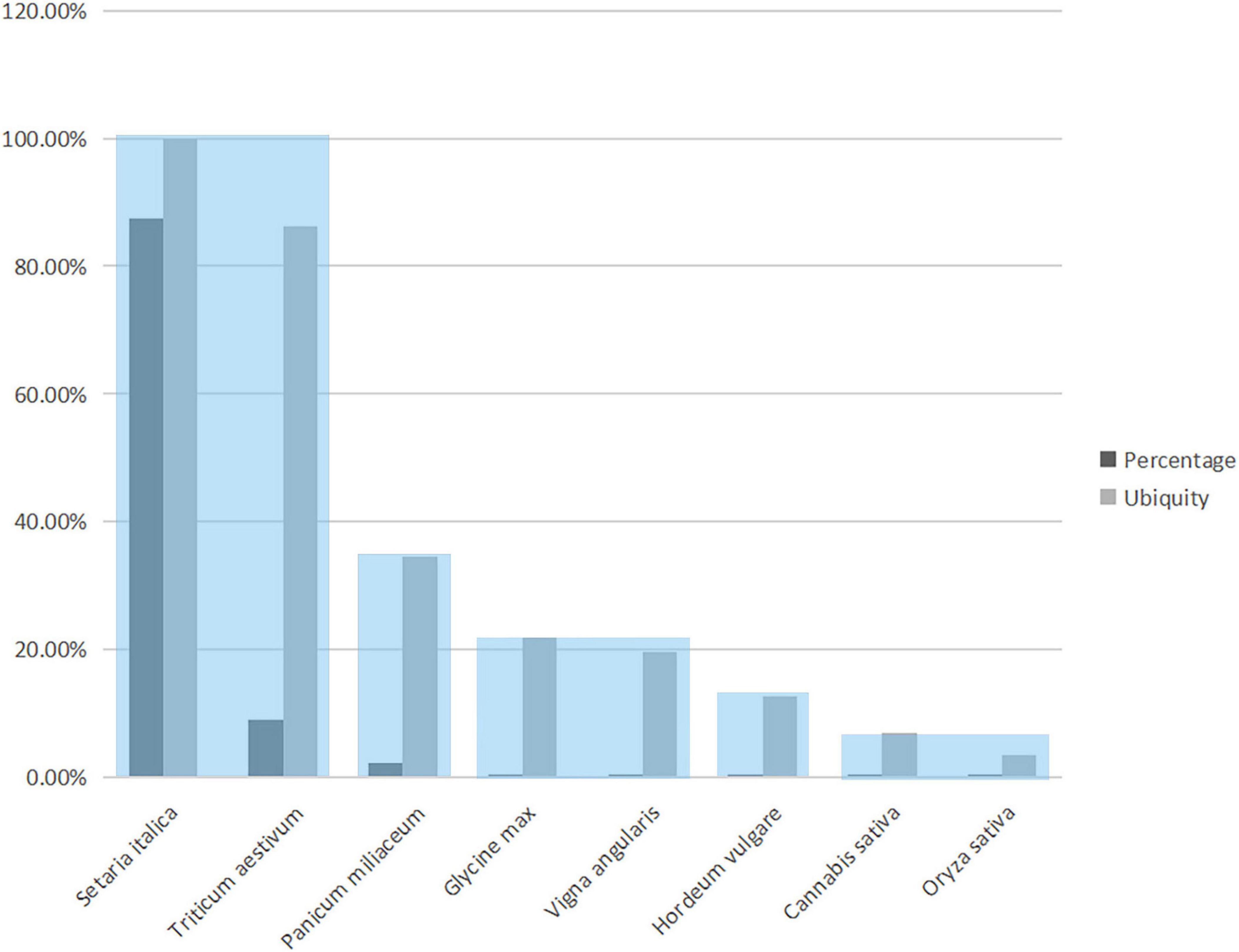
Figure 5. Crop percentage of absolute quantity and ubiquity at Matengkong from the Warring States Period to Qin Dynasty (N = 87).
Foxtail millet and broomcorn millet were typical dryland crops in northern China in ancient times, and they were characterized by their strong stress tolerance, drought resistance, barren tolerance, and salinity resistance (Yu, 2003). Wheat was the second main crop in the dryland farming system at Matengkong after foxtail millet. Legumes, including soybean and adzuki bean, provide plant-based protein and are important crops as well. Barley, cannabis, and rice account for a small percentage of crops, which means that they may have been used as some kind of supplementary crops in the multi-variety planting system. Although the cannabis seeds from the female plant are described as an edible food in Shi Jing 诗经 (Liu, 2017), the slender fiber was more extensively used for weaving clothes in ancient China (Zhao, 2010; Liu and Sun, 2019). Thus, few cannabis seeds were found at most of the sites in China, which can be attributed to their utilization (Liu, 2017).
The flotation results show that the inhabitants of Matengkong practiced dryland farming that largely consisted of foxtail millet and wheat. Broomcorn millet was a kind of supplementary crop. Considering the many advantages of the multivariate crop planting system, it may have motivated the Qin people’s social progress. These advantages include raising the total value of agricultural output, reducing natural disasters, and increasing the diversity of crops (Zhao, 2005, 2011).
It had been around 2,000 years since wheat was diffused into the Yellow River region from West Asia (Zhao and Fang, 2007; Wang et al., 2011; Zhouyuan Archaeological Team, 2011; Jin et al., 2013; Ma, 2017; Zhao, 2019). The use of wheat had been well documented in China’s history. For example, regardless of whether the concepts were five grains 五谷, six grains 六谷, or nine grains 九谷 as recorded in Zhou Li 周礼, wheat was involved as a significant crop (Yang, 2010). Master Lv’s Spring and Autumn Annals 吕氏春秋 indicated that in the first month of summer when peasants delivered new wheat, the king would taste it along with pork after offering it to the ancestral temple. In addition, in the second month of autumn, people were urged to sow wheat and not to miss the farming season. Those who failed would be punished accordingly (Tang, 2010; Yang, 2010). Therefore, it can be inferred that wheat was closely related to people’s daily life in the Zhou Dynasty, and wheat cultivation was closely associated with national sacrifices and ordinances.
Wheat appears to have become increasingly important in agricultural production during the Bronze Age in China (Zhao and Fang, 2007; Wang et al., 2011; Zhouyuan Archaeological Team, 2011; Jin et al., 2013; Ma, 2017; Zhao, 2019; Deng et al., 2020; Tang et al., 2022; Supplementary Figures 1, 2). However, there is a contrast in the data analysis of wheat from this site. Compared with the main crop foxtail millet, the ubiquity of wheat is the second highest (Figure 5), whereas the percentage of the absolute quantity and density are quite low (Figures 5, 6 and Supplementary Table 2).
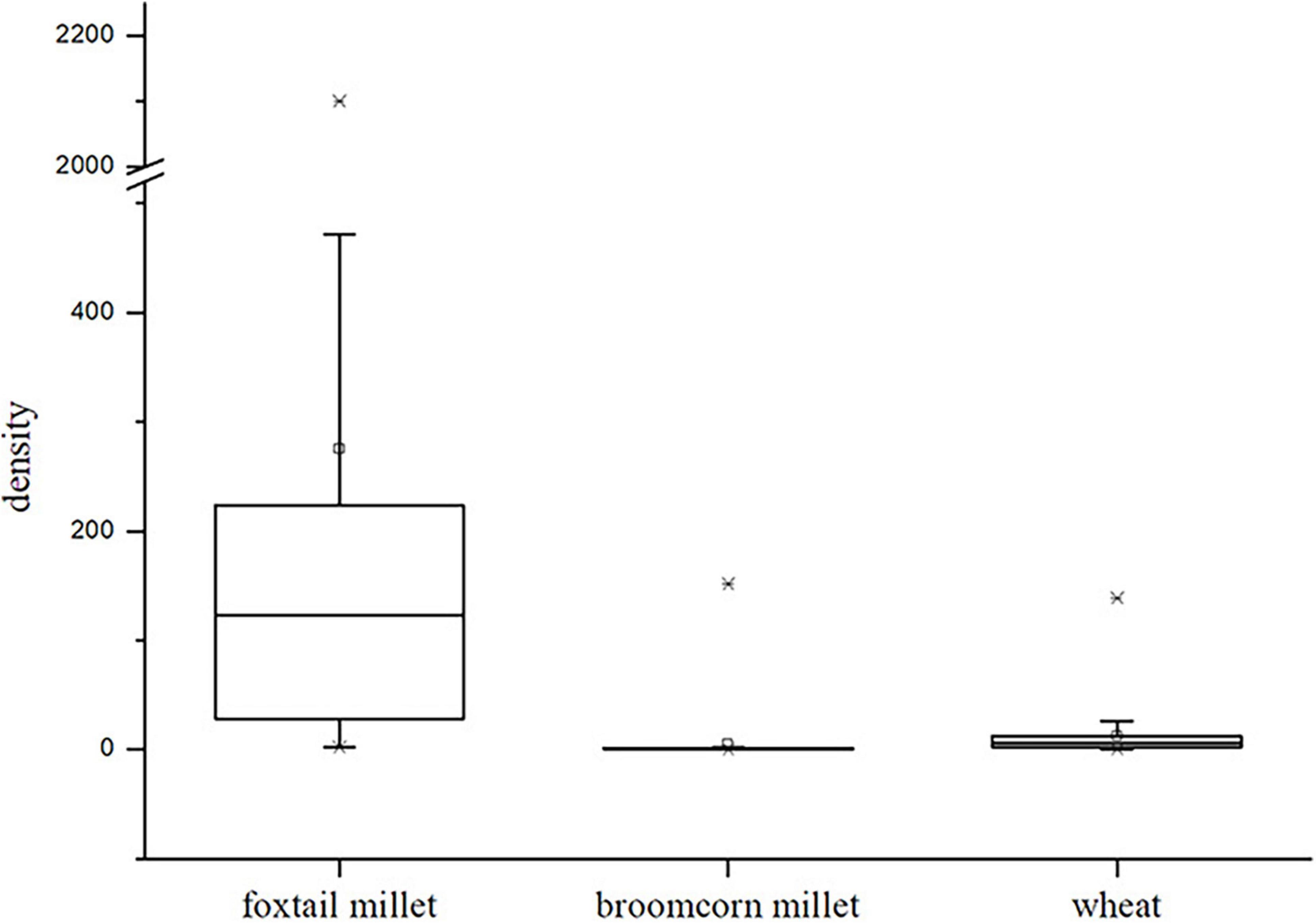
Figure 6. Box plots of the densities of foxtail millet, broomcorn millet and wheat from Matengkong site.
Thousand Kernel Weight (TKW), rows per ear, ear diameter, kernels per row, and kernel percentage were found to be positively correlated with yield. Unfortunately, TKW was the only available item to roughly calculate the weight ratio of foxtail millet and wheat that were deserted at this site given that the crop remains are almost kernels (Table 3). The modern range of foxtail millet TKW is 1.31–3.46 g (Wu et al., 2021) and the modern range of wheat TKW is 32–40 g (Yu, 2003). Table 3 reveals that the range of the weight ratio of the two crops available at Matengkong is 0.39–0.83, as follows:

Table 3. The original weight of seeds and the ratio between foxtail millet and wheat at Matengkong based on their quantity and TKW.
where N1 = number of foxtail millet grains, N2 = number of wheat grains, P1 = Weight ratio of foxtail millet and wheat, P2 = Weight ratio of foxtail millet and wheat.
Given the condition that the bigger grains might be less easy to save at archeological sites so that wheat is supposed to be much more than its quantity available at Matengkong because it could easily be picked up by the inhabitants of Matengkong and easily uncharred than millet seeds (Jin et al., 2012; Wang et al., 2015; Zhao, 2019), the weight ratio of the two crops available at Matengkong would be much lower. In view of the range of the modern per unit yield ratio of foxtail millet and wheat is 0.43–0.63, it suggests that the wheat was cultivated by most households and its yield was as high or the same as foxtail millet.
Although wheat planting played an important role in the agricultural economy of the Qin people, it appears to have provided only a small part of their dietary intake. The δ13C analysis of the skeletons of the Qin people unearthed from other nearby sites revealed that their vegetative food was reliant on C4 plants which account for approximately 80% of it (Cai and Qiu, 1984; Zhang et al., 2003; Wei et al., 2009; Ling, 2010; Ling et al., 2010a,b, 2019; Wang et al., 2019; Table 4 and Supplementary Figure 4). Hence, it would be useful for further research on the isotope analysis of the Qin people’s skeletons of Matengkong to be carried out in the future.
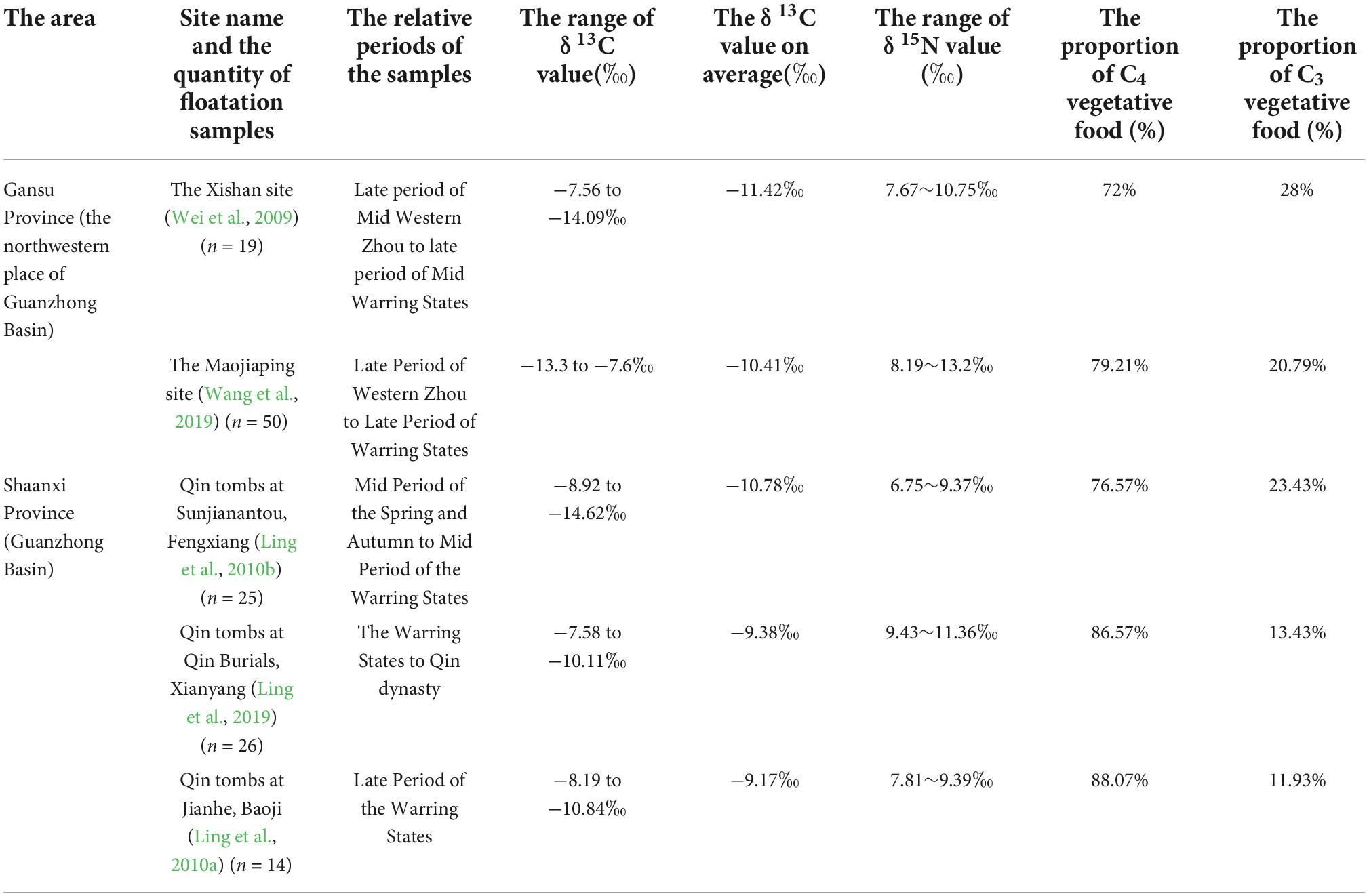
Table 4. Human bone δ 13C and δ 15N values before and after the Qin people entered the Guanzhong area.
Rice originated in the middle and lower reaches of the Yangtze River in China. Given only 10 grains of rice have been found, it can be inferred that it was of little importance to the Qin people’s agricultural production and their diet at the Matengkong site. The flotation results from the sites of the Zhou Dynasty also provide evidence of rice being rare in the region of the Middle Yellow River (Tang et al., 2022). Compared with this, at Xinjie, a Neolithic site in the Guanzhong Basin, plenty of rice remains, including grains and spikelet bases, were found (Zhong et al., 2015).
This situation may echo the decreasing intensity of the Holocene Asian Monsoon since 4,500 a BP (Wang et al., 2005), and the intensity of the monsoon is positively correlated with precipitation. Wang et al.’s (2005) study reveals the increasing intensity of the monsoon which had restarted from around 500 a BP, and the level of recent times had almost been as high as the Yangshao Period (7,000–5,000 a BP). This situation might be supported by the fact that today there are over 50 ha of paddy fields at Wangmang Town by the northern foothills of the Qinling Mountains, only 30 km away from Matengkong (Supplementary Figures 5, 6).
Within the analysis, no rice spikelet bases were recovered from the samples from Matengkong. Rice spikelet bases are one of the waste by-products from the process of de-husking, and their presence would normally indicate that the rice was grown locally (Fuller and Weber, 2005). As such, given their absence, there is no supporting evidence that rice was grown at Matengkong, and the resulting possibility is that rice might have been introduced from the Chu, a neighboring state to the south of Qin.
It is worth noting that three bronzes items (one tripod, one wine jar, and one basin) in Chu style were unearthed from Matengkong (Wang and Xu, 2019), based on which it can be inferred that there was communication between the Qin and Chu, who were located in the north and south of the huge Qinling–Dabashan Mountains, respectively. The ancient mountain passage likely played an important role in the connection between the Qin and the Chu, e.g., Shang-Wu Road (Quan, 2015; Xu and Pei, 2016) was one such mountain passage and it is still available for use (Figure 1 and Supplementary Figure 3).
The quantity and ubiquity of adzuki beans from Matengkong were higher than those in other contemporary sites. Thus, such beans were certainly an important resource (CASS, 1959; Zhao, 2010; Wei et al., 2017; Wang, 2018; Wei, 2018; Guo et al., 2019; Liu and Sun, 2019; Ma et al., 2019; Zhong et al., 2020). Compared with soybeans, adzuki beans are much easier to boil thoroughly, much milder in flavor, and rich in protein and vitamins (Liu and Sun, 2019); this is why it was favored by the Matengkong people.
According to studies on molecular genetics, the origin of adzuki beans domestication is polycentric; the area of origin includes China as well as Japan and the western regions of the Himalayas (Yamaguchi, 1992; Zong et al., 2003; Tao, 2017). Archeological evidence showed that the starch of Vigna spp. existed at the sites from the Upper Paleolithic Period to the middle Neolithic Period (Liu et al., 2010, 2014; Yang and Jiang, 2010; Liu L. et al., 2013; Chen, 2019; Sun et al., 2019). In other words, the ancient inhabitants of northern China had acquainted themselves with gathering, grinding, and eating Vigna spp. 10,000 years ago.
The oldest established presence of carbonized adzuki beans was found in the Liangchengzhen site in Shandong Province, where they are associated with the Longshan Culture (2,600-1,900 BC) (Crawford et al., 2005). Tao’s (2017) study showed that the adzuki bean (Vigna angularis) had been an important crop since the period of the Shang and Zhou dynasties. However, the domestication of the bean began in China during the Longshan Period (Crawford et al., 2005; Tao, 2017). In fact, the number of sites from which adzuki beans were unearthed was obviously more during the period from the Zhou dynasty to the Han dynasty when the utilization of adzuki beans was expanded (Figure 7 and Supplementary Figure 7).
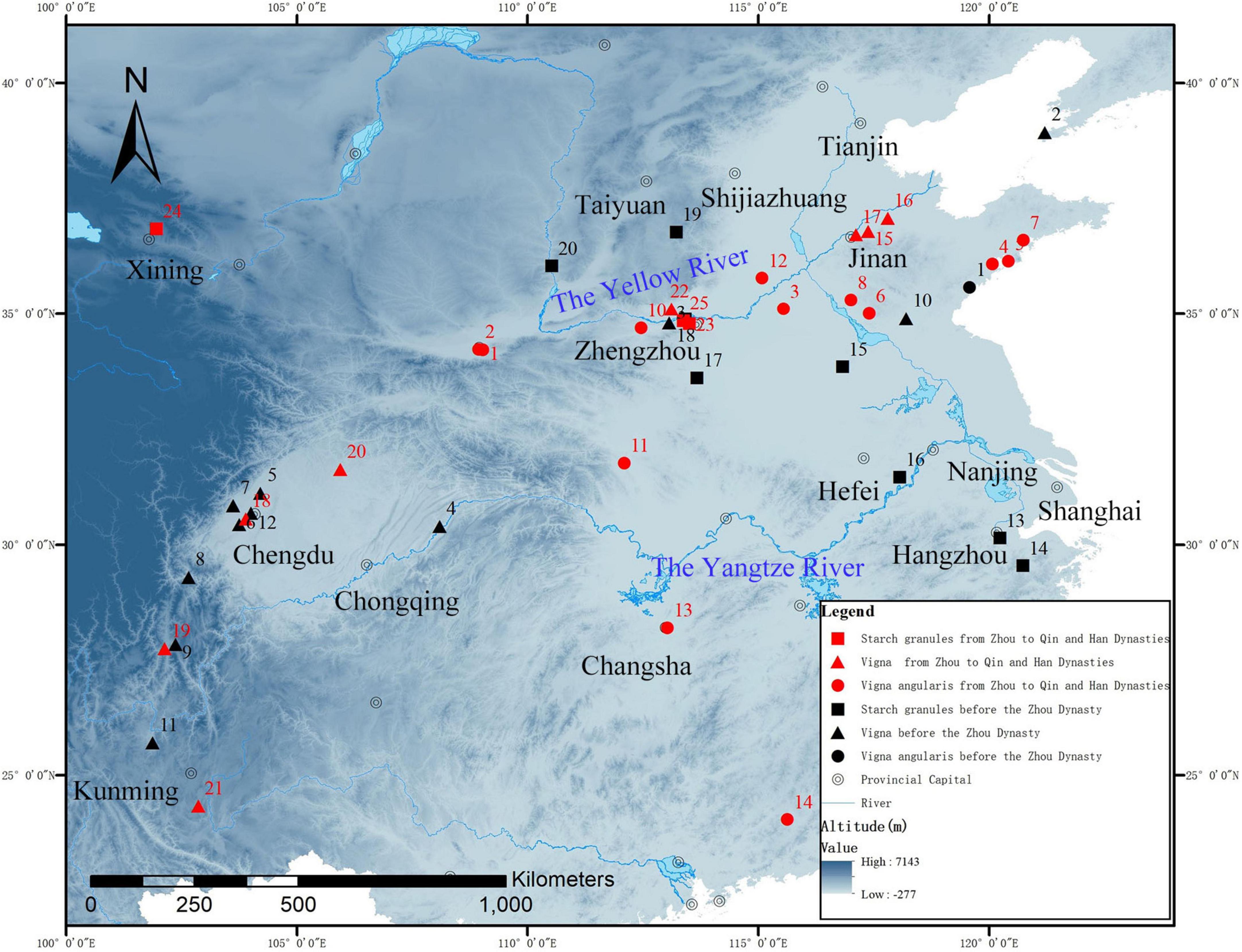
Figure 7. The distribution of Vigna and Vigna angularis unearthed from archeological sites in China. Vigna angularis, Vigna, Starch granules before the Zhou Dynasty: (1) Liangchengzhen, (2) Wangjiacun, (3) Huadizui, (4) Zhongba, (5) Guiyuanqiao, (6) Baodun, (7) Zhonghaiguoji, (8) Longwangmiao, (9) Henglanshan, (10) Yangguanzhuang, (11) Dadunzi, (12) Jinsha, (13) Kuahuqiao, (14) Xiaohuangshan, (15) Shishanzi, (16) Lingjiatan, (17) Jiahu, (18) Qingtai, (19) Niubiziwan, (20) Shizitan. Vigna angularis, Vigna, Starch granules from Zhou to Qin and Han Dynasties: (1) Matengkong, (2) Han Tombs of Xi-An City, (3) Shilipubei, (4) Longquanhedong, (5) Henanzhuang, (6) Beitaishang, (7) Beiqian, (8) The Ancient Capital City Site of the Zhu Kingdom, (9) Qingzhuangzi, (10) Han tombs at Shaogou Village in Luoyang, (11) Huanggang, (12) Jinqiao, (13) Mawangdui Tomb M1, (14) Shixiongshan, (15) Huangsangyuan, (16) Chenzhuang, (17) Daxinzhuang, (18) Sanguantang, (19) Shapingzhan, (20) Zhengjiaba, (21) Guangtoufen, (22) Xijincheng, (23) Dongzhao, (24) Fengtai, (25) Guanzhuang.
There are some records of the planting of adzuki beans in the ancient Chinese agricultural literature, such as Fan Sheng Zhi Shu 氾胜之书 (Late Western Han Dynasty) (Wan, 1980), Si Min Yue Ling 四民月令 (Late Eastern Han Dynasty) (Miao, 1981), and Qi Min Yao Shu 齐民要术 (Northern Wei) (Miao, 1982). The archeological distribution of the adzuki bean mirrors the location of these historical documents, which includes contemporary Henan, Shanxi, and Shaanxi provinces.
Besides crops, some other plants, such as Chenopodium sp. and Vitex negundo, appear to have been intentionally used by the Qin People because of the high density in each single sample (Supplementary Table 1). Both of these plants are multifunctional; however, their functions appear to be ambiguous due to the lack of multiple lines of archaeological evidence, which is a typical limitation of archeology.
Chenopodium spp. have often been unearthed at northern sites in China (Zhao, 2019). In terms of function, the stems and leaves of Chenopodium album are a kind of suitable fodder for poultry (Wu et al., 2003; Qiang, 2009) as well as an edible wild herb for the Chinese people (Zhao, 2019). Although the nutlets of Chenopodium spp. are not an ideal food for human beings due to their small size and the hard seed coat, they can be gathered for food when the tassels are ripe (Fan, 2019). It should be noted that a similar situation with a high density of Chenopodium spp. also appeared at other sites (Ma et al., 2015; Zhao, 2017, 2019; Zhao and Liu, 2019; Fu et al., 2022), and there was even a report that C. giganteum was identified from the burial pits of the Han Yangling Mausoleum of the early Western Han Dynasty, an era following the Qin Dynasty (Yang et al., 2009), in which the function of C. giganteum has not been rigorously reported.
Therefore, we suggest two hypotheses for the reason a large number of Chenopodium sp. seeds were concentrated in one single ash pit at Matengkong. It might have been gathered for poultry fodder or it may have been used in a specific type of human food.
Neither of these hypotheses is strongly supported, and both focus on the issue of whether domestication of certain types of these plants occurred in the past, this question remains unanswered in China. First, in terms of plant taxonomy, the Chenopodium plants can be divided into approximately 250 species globally, among which 20 species can probably be considered to have been distributed in China (Qiang, 2009), and the seeds of Chenopodium plants are quite similar. Second, unlike in the United States of America (Smith and Yarnell, 2009; Fritz et al., 2017), there are no explicit standards in Chinese archeological academia for investigating Chenopodium domestication. Third, as mentioned above, the functions of Chenopodium plants are quite diverse. This calls for more archeological exploration and archaeobotany in China to better understand the functions of Chenopodium plants.
In addition, the density of Vitex negundo (2,384/10 L) from one sample was found to be very high as well. Its fiber may have been used for basket weaving (Zhang and Liang, 2009). Besides that, if the nutlets were intentionally stored, they may have been consumed as “famine food” using certain cooking methods (Fan, 2019). Vitex negundo has other functions, such as medical and insect repellent (Wu et al., 1994). However, it is still not clear whether people at that time had realized these alternative uses.
Matengkong was a small low-status settlement arising from the Qin people inhabiting the Guanzhong Basin from the Warring States Period to the Qin Dynasty. This study is an archaeobotanical analysis of the flotation results of 87 soil samples from the Matengkong site. The flotation results showed that the inhabitants practiced multi-cropping focusing on dry farming. The crop assemblage comprised five categories in descending order of importance, including dominant foxtails millet and wheat, important broomcorn millet, less important soybean and adzuki bean, less utilized barley, and lowest ubiquitous cannabis and rice. Within them, the quantity of foxtail millet and wheat together accounted for 96.58% of the crops, and their ubiquity was recorded over 85%. The low percentage of the absolute quantity of wheat and its low density are in contrast with its high ubiquity. However, in view of the TKW and the modern per unit yield ratio of foxtail millet and wheat, it suggests that wheat was a consistent element of subsistence, even if it was largely overshadowed by millets as shown in both the charred and isotopic analysis. In other words, wheat planting played an important role in the agricultural economy of the Qin people, while it appears to have provided a small part of their dietary intake. It appears that rice could not have been an important part of Qin subsistence at the site, as there is no proper evidence that Merangkong people cultivated rice locally; it originated from Qin’s southern neighbor, Chu, through an ancient mountain passage. Adzuki beans were widely used as a crop resource during the Zhou Dynasty period. In addition, Chenopodium sp. and Vitex negundo appear to have been used intentionally, which can be inferred from the high density of each single sample; however, there is no definite opinion about how people used them in view of their versatility. This study compensates for the lack of archaeobotanical research on the Qin people, and of course, further flotation work and isotopic studies on the Qin people should be carried out in the future to supplement research on the Qin people.
The original contributions presented in this study are included in the article/Supplementary material, further inquiries can be directed to the corresponding authors.
LT, HZ, and ZZ conceived and designed the study. LT and ZW collected the data. LT, HZ, JZ, JL, and ZG analyzed the data and wrote the manuscript. All authors contributed to the article and approved the submitted version.
This research was supported by 111 project (D18004).
All works were conducted with support from the team of archeologists from the Shaanxi Academy of Archeology. We are grateful to them for their help in the soil samples collection, flotation, and transport. We thank Mr. Jingang Yang from the Paleoethnobotany Laboratory, Institute of Archeology, CASS for identifying the crop seeds. We also thank Ruichen Yang, Kai Han, Wenbin Fu, and Anqi Yang from the School of Cultural Heritage of Northwest University (Xi’an) for their help with seeds identification, data processing, and photographs, as well as their suggestions on the drafts.
The authors declare that the research was conducted in the absence of any commercial or financial relationships that could be construed as a potential conflict of interest.
All claims expressed in this article are solely those of the authors and do not necessarily represent those of their affiliated organizations, or those of the publisher, the editors and the reviewers. Any product that may be evaluated in this article, or claim that may be made by its manufacturer, is not guaranteed or endorsed by the publisher.
The Supplementary Material for this article can be found online at: https://www.frontiersin.org/articles/10.3389/fevo.2022.992980/full#supplementary-material
Cai, L. Z., and Qiu, S. H. (1984). Carbon Thirteen Determination and Ancient Dietary Research. Archaeology 10, 949–955.
Chen, T. (2019). Study on the Function of Grinding Stone Tools in Prehistoric China from the Perspective of Archaeological Evidence. Agricult. Archaeol. 6, 124–130.
Crawford, G., Underhill, A., Zhao, Z. J., Lee, G. A. H., Feinman, G., Nicholas, L., et al. (2005). Late Neolithic Plant Remains from Northern China: Preliminary results from Liangchengzhen, Shandong. Curr. Anthropol. 2, 309–317. doi: 10.1086/428788
Deng, Z. H., Fuller, D. Q., Chu, X. L., Cao, Y. P., Jiang, Y. C., Wang, L. Z., et al. (2020). Assessing the occurrence and status of Wheat in late Neolithic central China: the importance of direct AMS radiocarbon dates from Xiazhai. Veget. History Archaeobot. 29, 61–73. doi: 10.1007/s00334-019-00732-7
Fritz, G. J., Bruno, M. C., Langlie, B. S., Smith, B. D., and Kistler, L. (2017). “Cultigen Chenopods in the Americas: A Hemispherical Perspective,” in Springer international publication, ed. P. Sayre Matthew (Netherlands: Springer), doi: 10.1007/978-3-319-52849-6_3
Fu, W. B., Di, N., Shao, J., Hu, S. M., Yang, R. C., and Zhao, Z. J. (2022). Analysis of flotation results of the miaoliang site in jingbian county, shaanxi province. Q. Sci. 1, 119–128.
Fuller, D. Q. (2008). “Archaeological science in field training,” in From concepts of the past to practical strategies: the teaching of archaeological field techniques, eds P. Ucko, L. Qin, and J. Hubert (London: Saffron Press), 183–205.
Fuller, D. Q., and Weber, S. A. (2005). Formation processes and paleoethnobotanical interpretation in South Asia. J. Interdisc. Stud. Hist. Archaeol. 2, 93–115.
Guo, R. Z., Guo, M. K., Sun, M., Wang, L., Wang, S. B., and Jin, G. Y. (2019). The Carbonized Plant Remains of Pre-Qin Period from Shilipubei Site, Heze City, Shandong Province. Agricult. Hist. China 5, 15–26.
Huang, C. C. (1988). Development and Utilization of Guanzhong Basin, Xi’an: Shaanxi People’s Publishing House, 127.
Jin, G. Y., Wang, C. M., Zheng, T. X., Gao, M. K., and Wei, C. M. (2012). Study of charred seed fruits from the Chenzhuang site in Gaocheng, Shandong. Cult. Relics Southern China 1, 147–155.
Jin, G. Y., Wang, Y. Q., Wang, H. Y., and Wu, W. W. (2013). Study on the Carbonized Plant Remains from Beiqian Site, Jimo, Shandong (2007). East Asia Archaeol. 10, 239–254.
Liang, Y. (2020). The Sound of Xichui: An Archaeological Interpretation of the Historical Records of Qin. Beijing: SDX Joint Publishing Company, 81–105.
Ling, X., Wang, W. S., Chen, L., Sun, L. J., and Hu, Y. W. (2010a). Stable Isotope Analysis of Qin Human Bones from Jianhe Cemetery in Baoji City, Shaanxi Province. Archaeol. Cult. Relics 1, 95–98.
Ling, X., Chen, L., Tian, Y. Q., Li, Y., Zhao, C. C., and Hu, Y. W. (2010b). Carbon and Nitrogen Stable Isotopic Analysis on Human Bones from the Qin Tomb of Sunjianantou Site, Fengxiang, Shaanxi Province. Acta Anthropol. Sin. 1, 54–61.
Ling, X., Wang, Y. S., Yue, Q., Xie, G. W., Chen, L., and Lan, D. (2019). Stable Carbon and Nitrogen Isotope Analysis of Human Bones from Burials of the Qin State in the Warring-States Period Excavated at Guangzhong Prison in Shaanxi. Relics Museol. 3, 69–73.
Liu, H., Hu, S. M., Zhang, P. C., Yang, Q. H., Jiang, H. E., Wang, W. L., et al. (2013). Results of Soil Samples Flotation from Two Yangshao Sites in Shaanxi and A Comparative Study. Archaeol. Cult. Relics 4, 106–112.
Liu, L., Bestel, S., Shi, J. M., Song, Y. H., and Chen, X. C. (2013). Paleolithic human exploitation of plant foods during the last glacial maximum in North China. Proc. Natl. Acad. Sci. U.S.A. 14, 5380–5385. doi: 10.1073/pnas.1217864110
Liu, L., Chen, X. C., and Shi, J. M. (2014). Use-wear and Starch Analyses on Grinding Stones at Niubiziwan, Wuxiang County, Shanxi. Archaeol. Cult. Relics 3, 109–118.
Liu, L., Judith, F., Alison, W., John, W., Jiang, L. P., Wang, H. M., et al. (2010). The Exploitation of Acorn and Rice in Early Holocene Lower Yangzi River, China. Acta Anthropol. Sin. 3, 317–336.
Liu, X. C., and Sun, Y. G. (2019). Flotation Results from the Qingzhuangzi Site, Shenyang City. Res. China Front. Archaeol. 1, 323–334.
Liu, X. L. (2017). Archaeological Research on Agriculture and Rural Settlements in Pre-Qin and Han Dynasties. Beijing: Cultural Relics Publishing House.
Liu, X. Y. (2014). Research on plant remains excavated at the Anban site in 2012, Ph.D thesis, Xi’an: Northwest University.
Ma, F. Q. (2017). Archaeological Research at the City Site of the Zhu State from Eastern Zhou to Western Han Periods with the Perspective of Paleoethnobotany: A Case Study Based on Macroremains in 2015. Ph.D thesis, Jinan: Shandong University.
Ma, F. Q., Chen, X. X., Lu, G. Q., and Wang, Q. (2019). Plant Macroremains Excavated from the Ancient Capital City Site of the Zhu Kingdom in Zoucheng, Shandong Province in 2015: Humans and Plants in the Perspective of Ancient Urban Management. Southeast Cult. 3, 57–69.
Ma, Y. C., Wu, W. W., Wang, Q., Zhang, C. M., and Jin, G. Y. (2015). Research on the remains of carbonized plants at the Wangjiacun site in Dalian. Northern Cult. Relics 2, 39–43.
Miao, Q. Y. (1981). The Compilation and interpretation of Si Min Yue Ling. Beijing: Agricultural Press.
National Cultural Heritage Administration (2012). Specification for the flotation work and laboratory analysis of archaeological plant remains. Beijing: Heritage Press.
Pearsall, D. M. (2000). Paleoethnobotany: A handbook of procedures. New York: Academic Press, 29–44.
Quan, X. J. (2015). A Preliminary Study on Eastern Zhou Bronze Ware in Shangluo Area, Ph.D thesis, Xi’an: Shaanxi Normal University.
Shang, X., Zhang, P. C., Zhou, X. Y., Qiu, Z. W., Qu, Y. T., Wang, W. L., et al. (2012). A Preliminary Study on Early Agricultural Activities at the Neolithic Site of Xiahe in Shaanxi Province. Archaeol. Cult. Relics 4, 55–59.
Smith, B. D., and Yarnell, R. A. (2009). Initial formation of an indigenous crop complex in eastern North America at 3,800 BP. Proc. Natl. Acad. Sci. U.S.A. 106, 6561–6566. doi: 10.1073/pnas.0901846106
Sun, Q. L., Shuo, Z., Wu, Y., and Yang, Y. M. (2019). Starch grain analysis of the grooved basin from the Lingjiatan site, Hanshan county, Anhui Province. Acta Anthropol. Sin. 1, 132–147.
Tang, L. Y., Yang, L. P., Ye, W., Yin, Y. P., Liu, X. Y., Zhao, Z. J., et al. (2020a). Exploration of the medicinal function of ancient herbs: A study on charred plant remains of pit H85 in Yangguanzhai site, Shaanxi province. Q. Sci. 2, 490–498.
Tang, L. Y., Yang, J. H., Guo, X., Tian, J., Han, K., and Zhang, X. Y. (2020b). The Consistency and the Disequilibrium of the Pre-Qin Agriculture at the Guanzhong Basin: A Study on the Gongbeiya Site, Xi’an, Shaanxi. Cult. Relics Southern China 4, 163–172.
Tang, L. Y., Zheng, Y., Zhu, J., Tian, J., Gao, X. P., and Han, G. H. (2022). Study on the utilization of crops in Zhou Dynasty around the Zhengzhou region: A case from Guanzhuang site, Xingyang. Q. Sci. 1, 129–143.
Tao, D. W. (2017). The preliminary analysis of adzuki (Vigna angularis) remains from archaeological sites in China. Western Archaeol. 3, 274–281.
Wang, H. Y., Liu, Y. C., and Jin, G. Y. (2011). Analysis on the Carbonized Plant Remains from the Dongpan Site, 2009, Linshu County, Shandong. East Asia Archaeol. 8, 357–372.
Wang, Q., Chen, X. X., Jiang, Z. L., and Fang, H. (2015). The significance of charcoal simulation experiments in phytoarchaeological research-Taking rice and wheat as examples. Cult. Relics Southern China 3, 192–198.
Wang, X. L. (2006). East and West Quanqiu and Qin people enter Long (Gansu). Archaeol. Cult. Relics 4, 60–65.
Wang, Y. J., Chen, H., Edwards, R. L., He, Y. Q., Kong, X. G., An, Z. S., et al. (2005). The Holocene Asian Monsoon:Links to Solar Changes and North Atlantic Climate. Science 308, 854–857. doi: 10.1126/science.1106296
Wang, Y. S., Ling, X., Liang, Y., Hou, H. W., Hong, X. Y., and Chen, L. (2019). Study on the Qin Ancestors’ Bones in Maojiaping Site at Gangu Country by carbon and nitrogen isotope analysis. J. Northwest Univ. 5, 729–735.
Wang, Z. Y., and Xu, Y. C. (2019). Archaeological excavation of Matengkong site in Xi’an, Shaanxi has achieved new results. China Cult. Relics News 8, 1–2.
Wang, Z. Z. (2018). Plant Macrofossil Analysis of Beitaishang Site in Tengzhou of Shandong Province, Ph.D thesis, Jinan: Shandong University.
Wei, M., Wang, T., Zhao, C. C., Chen, L., and Wang, C. S. (2009). Diet and Oral Hygiene of the People in Early Qin Dynasty from the Xishan Site, Gansu Province. Acta Anthropol. Sin. 1, 45–56.
Wei, N. (2018). The Research of Agricultural Activities and Utilization of Wild Plants during the Zhou Dynasty in Jiaodong Region, Ph.D thesis, Jinan: Shandong University.
Wei, N., Ai, S. L., Guo, R. Z., Hou, C. L., Jin, G. Y., and Lin, Y. H. (2017). Research on Charred Plant Remains of Zhou Dynasty from the Henanzhuang Site, in Qingdao County, Shandong Province. East Asia Archaeol. 00, 214–227.
Wu, C. L., Sun, J. X., Guo, P. Y., Wang, H. F., and Wu, X. H. (2021). Effects of Agronomic Managements on Yield and Lodging Resistance of Millet. Scient. Agricult. Sin. 6, 1127–1142.
Xu, W. M., and Pei, B. (2016). The history and culture of shangwu road and its development and utilization. Qin Han Stud. 00, 111–115.
Yamaguchi, H. (1992). Wild and weed Azuki bean in Japan. Econ. Bot. 4, 384–394. doi: 10.1007/BF02866509
Yang, X. Y., and Jiang, L. P. (2010). Starch grain analysis reveals ancient diet at Kuahuqiao site, Zhejiang Province. Chin. Sci. Bull. 7, 596–602. doi: 10.1007/s11434-009-0545-0
Yang, X. Y., Liu, C. J., Zhang, J. P., Yang, W. Z., Zhang, X. H., et al. (2009). Plant crop remains from the outer burial pit of the Han Yangling Mausoleum and their significance to Early Western Han agriculture. Chin. Sci. Bull. 13, 1738–1743. doi: 10.1007/s11434-009-0048-z
Zhang, M. D. (2016). China National Geographic Encyclopedia 9 Shaanxi, Gansu, Qinghai, Ningxia, Vol. 38. Beijing: Beijing United Publishing Company, 30–32.
Zhang, X. L., Wang, J. X., Xian, Z. Q., and Qiu, S. H. (2003). Research on the food structure of ancient humans. Archaeology 2, 158–171.
Zhang, X. Q., and Liang, Y. L. (2009). Talking about the development and utilization value of Huang Jing. Modern Agricult. Sci. Technol. 22, 128–129.
Zhao, Z. J. (2004). Flotation: a field technique of Paleothnobotany for recovering plain remains. Archaeology 3, 80–87.
Zhao, Z. J. (2005). On the distinctive features of agricultural economy during the formation of Xia Shang Zhou civilization. Huaxia Archaeol. 1, 75–81.
Zhao, Z. J. (2011). Characteristics of agricultural economy during the formation of ancient Chinese civilization. J. Natl. Museum China 1, 19–31.
Zhao, Z. J. (2017). The Development of Agriculture in the Time of Yangshao Culture and the Establishment of Agricultural Society: an Analysis on the Flotation Result of Yuhuazhai Site. Jianghan Archaeol. 6, 98–108.
Zhao, Z. J. (2019). Changes and Development of Ancient Agriculture on Weihe Plain-An Analysis of Plant Remnants Excavated from Dongyang Site in Huaxian District. Huaxia Archaeol. 5, 70–84.
Zhao, Z. J., and Fang, Y. M. (2007). Flotation results from the Wangchenggang site, Dengfeng County of Henan. Huaxia Archaeol 2, 78–89.
Zhao, Z. J., and Liu, C. (2019). Analysis and Discussion on Flotation Results from the Erlitou Site in Yanshi City. Agricult. Archaeol. 6, 7–20.
Zhao, Z. J., and Xu, L. G. (2004). Results and Preliminary Analysis of Trial Flotation at Zhouyuan Site (Wangjiazui Site). Cult. Relics. 10, 89–96.
Zhong, H., Cui, Z. L., and Yuan, G. K. (2020). Preliminary Study on Agricultural Production Mode in Heji Area During Eastern Zhou Dynasty: Plant Remains Unearthed at the Jingiao Site in Puyang. Agricult. Archaeol. 4, 18–27.
Zhong, H., Yang, Y. C., Shao, J., and Zhao, Z. J. (2015). The Research on the Remains of the Carbonized Plant in the New Street Site, Lantian County, Shaanxi Province. Cult. Relics Southern China 3, 36–43.
Zhouyuan Archaeological Team (2011). The excavation of the bronze casting remains in locus west of Zhuangli village at Zhouyuan site in the spring of 2003 and 2004. Acta Archaeol. Sin. 2, 245–316.
Keywords: Qin people, Eastern Zhou Dynasty, Guanzhong Basin, archaeobotany, multi-cropping, wheat, rice
Citation: Tang L, Zhou H, Wang Z, Zhu J, Liu J, Gao Z and Zhao Z (2022) Agricultural practices of the Qin people from the Warring States period to the Qin Dynasty: A case from the Matengkong site in Guanzhong Basin, China. Front. Ecol. Evol. 10:992980. doi: 10.3389/fevo.2022.992980
Received: 13 July 2022; Accepted: 05 October 2022;
Published: 20 October 2022.
Edited by:
Shinya Shoda, University of York, United KingdomReviewed by:
Chris Stevens, University of Cambridge, United KingdomCopyright © 2022 Tang, Zhou, Wang, Zhu, Liu, Gao and Zhao. This is an open-access article distributed under the terms of the Creative Commons Attribution License (CC BY). The use, distribution or reproduction in other forums is permitted, provided the original author(s) and the copyright owner(s) are credited and that the original publication in this journal is cited, in accordance with accepted academic practice. No use, distribution or reproduction is permitted which does not comply with these terms.
*Correspondence: Liya Tang, dGFuZ2xpeWFAbnd1LmVkdS5jbg==; Zhiyou Wang, d2FuZ3poaXlvdUAxMjYuY29t
†These authors have contributed equally to this work
Disclaimer: All claims expressed in this article are solely those of the authors and do not necessarily represent those of their affiliated organizations, or those of the publisher, the editors and the reviewers. Any product that may be evaluated in this article or claim that may be made by its manufacturer is not guaranteed or endorsed by the publisher.
Research integrity at Frontiers

Learn more about the work of our research integrity team to safeguard the quality of each article we publish.